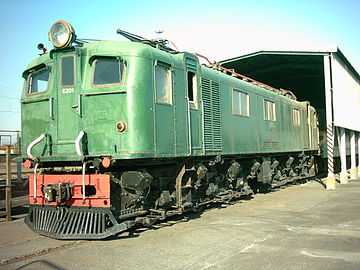South African Class 3E
| South African Class 3E | |
|---|---|
|
No. E201 at Bellville Loco, Cape Town, 29 April 2004 | |
| Type and origin | |
| Power type | Electric |
| Designer | Metropolitan-Vickers |
| Builder | Robert Stephenson and Hawthorns |
| Serial number | RSH 7215-7242 [1] |
| Model | Metrovick 3E |
| Build date | 1947 |
| Total produced | 28 |
| Specifications | |
| UIC classification | Co+Co interlinked bogies |
| Gauge | 3 ft 6 in (1,067 mm) Cape gauge |
| Bogies | 4.267 m (14 ft) wheelbase |
| Wheel diameter | 1,219 mm (48 in) |
| Wheelbase | 12.801 m (42 ft) |
| Length | 17.199 m (56 ft 5.1 in) |
| Height | 4.089 m (13 ft 5 in) pantographs down |
| Axle load |
18,796 kg (18.5 long tons) on bogie outer axles 19,305 kg (19 long tons) on bogie centre axles |
| Locomotive weight | 113,797 kg (112 long tons) |
| Current collection method | Pantographs |
| Traction motors | Six MV 187 |
| Transmission | 23/71 Gear ratio |
| Performance figures | |
| Maximum speed | 105 km/h (65 mph) |
| Power output |
Per motor: 336 kW (451 hp) 1 hour 284 kW (381 hp) continuous Total: 2,016 kW (2,704 hp) 1 hour 1,704 kW (2,285 hp) continuous |
| Tractive effort |
204 kN (46,000 lbf) starting 151 kN (34,000 lbf) 1 hour 119 kN (27,000 lbf) continuous |
| Train brakes | Air & Vacuum |
| Career | |
| Operator(s) | South African Railways |
| Class | Class 3E |
| Power class | 3 kV DC |
| Number in class | 28 |
| Number(s) | E191-E218 [2] |
| Delivered | 1947-1948 |
| First run | 1947 |
The South African Class 3E of 1947 is a South African electric locomotive from the South African Railways era.
In 1947 and 1948 the South African Railways placed twenty-eight Class 3E electric locomotives with a Co+Co wheel arrangement in mainline service.[3]
Manufacturer
The South African Railways (SAR) placed orders for the design and construction of the 3 kV DC Class 3E electric locomotive with Metropolitan-Vickers (Metrovick) in 1944. Although the locomotive was designed by Metrovicks, who also supplied the electrical equipment, its construction was subcontracted to Robert Stephenson and Hawthorns (RSH). Twenty-eight locomotives were delivered and placed in service in 1947 and 1948, numbered in the range from E191 to E218.[1][3]
Characteristics
These dual cab locomotives have three windows between the side doors on one side and four on the opposite side. When the locomotive is observed from the side with three windows, its no. 1 end will be to the viewer’s left.[2]
Like the Classes 1E, 2E and 4E, the Class 3E has bogie mounted draft gear, therefore no train forces are transmitted to the locomotive body. It has a Co+Co wheel arrangement with an articulated inter-bogie linkage.[2]
For the passenger role, provision was made for both electric and steam heating of passenger coaches, although the electric heating feature was never used on mainline passenger trains. The Class 3E had an integral steam boiler for train heating, unlike subsequent electric locomotive models like the Class 4E, Class 5E and Class 6E that used separate steam wagons on passenger service.[3]
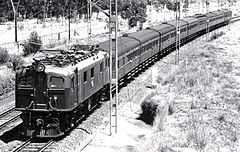
Unlike Cape Town's and Durban's suburban trainsets, those working around Johannesburg had jumper connections on the roof above the end connecting doors. The Class 3Es were also equipped with these connections, immediately to the right of each headlight. During a shortage of suburban motor coaches circa 1948-1949, Class 3Es were used to haul suburban sets on the Witwatersrand and it is likely that the electric heating system was used during those winters. The picture alongside, a rare shot showing snow on the ground along the Johannesburg-Pretoria line on the Transvaal Highveld, the roof jumper connections between the suburban coaches and next to the unit's headlight are visible.
Service
The Class 3E was the first six-axle electric locomotive in SAR service and, with a maximum safe speed of 105 kilometres per hour (65 miles per hour), was designed for use where higher speeds were possible on track with less severe curvature than on the lower Natal mainline. It first entered service in Natal, but eventually served mainly on the Witwatersrand in both freight and passenger working.[3]
Preservation
No. E201, one of two known survivors of the Class, is being staged under a shelter at the Bellville locomotive depot in Cape Town along with a few other early SAR electric locomotives that were earmarked for preservation.[1]
Works numbers
The RSH works numbers of the Class 3E are shown in the table.[1]
| Loco no. |
Works no. |
|---|---|
| E191 | 7215 |
| E192 | 7216 |
| E193 | 7217 |
| E194 | 7218 |
| E195 | 7219 |
| E196 | 7220 |
| E197 | 7221 |
| E198 | 7222 |
| E199 | 7223 |
| E200 | 7224 |
| E201 | 7225 |
| E202 | 7226 |
| E203 | 7227 |
| E204 | 7228 |
| E205 | 7229 |
| E206 | 7230 |
| E207 | 7231 |
| E208 | 7232 |
| E209 | 7233 |
| E210 | 7234 |
| E211 | 7235 |
| E212 | 7236 |
| E213 | 7237 |
| E214 | 7238 |
| E215 | 7239 |
| E216 | 7240 |
| E217 | 7241 |
| E218 | 7242 |
Sides illustrated
The main picture and the following photographs offer views of all sides of the Class 3E locomotive.
-
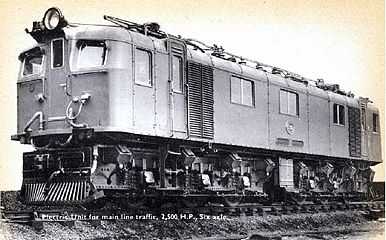
SAR&H publicity picture of no. E192, c. 1947, showing the "left" side with three side windows, two small grilles on the lower body side and the jumper connection next to the headlight
-
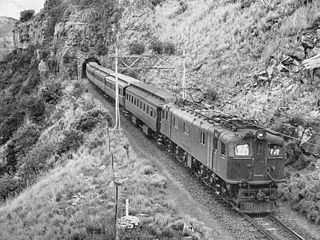
Class 3E exiting the tunnel between New Formosa and New Beacon Hill stations on the old 1918 Mooirivier-Estcourt deviation, abandoned c. 1957
-
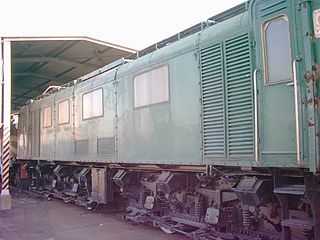
No. E201, showing the "right" side with four side windows and two large grilles on the lower body side, Bellville Loco, 29 April 2004
See also
- List of South African locomotive classes
- Numbering and classification: Electric locomotives
- South African locomotive history
References
|
- ↑ 1.0 1.1 1.2 1.3 Middleton, John N. (2002). Railways of Southern Africa Locomotive Guide - 2002 (as amended by Combined Amendment List 4, January 2009) (2nd, Dec 2002 ed.). Herts, England: Beyer-Garratt Publications. pp. 50, 62.
- ↑ 2.0 2.1 2.2 South African Railways Index and Diagrams Electric and Diesel Locomotives, 610mm and 1065mm Gauges, Ref LXD 14/1/100/20, 28 January 1975, as amended
- ↑ 3.0 3.1 3.2 3.3 Paxton, Leith; Bourne, David (1985). Locomotives of the South African Railways (1st ed.). Cape Town: Struik. p. 126. ISBN 0869772112.
